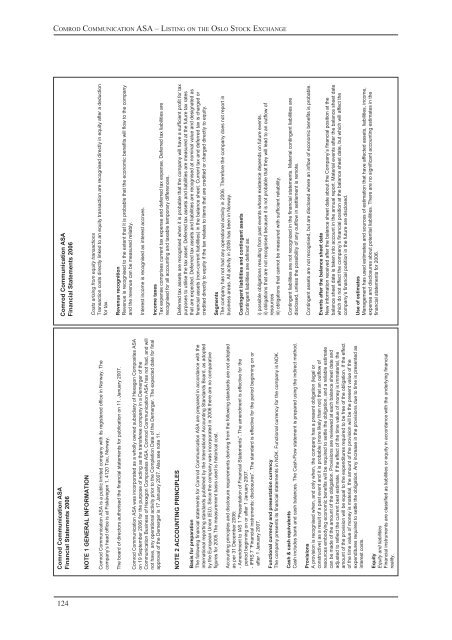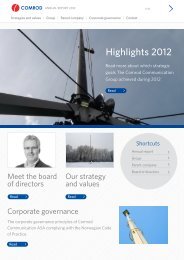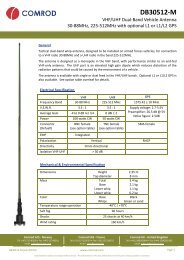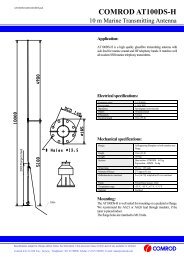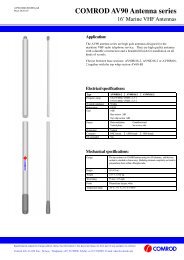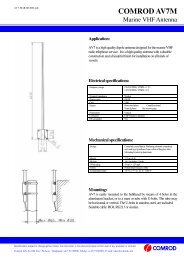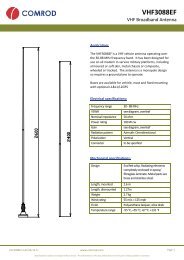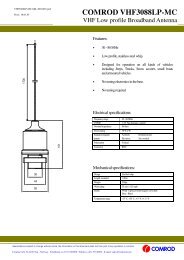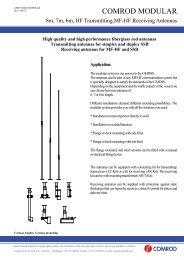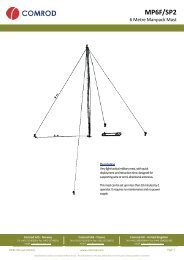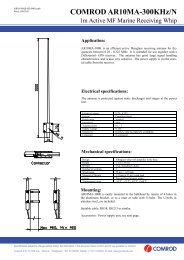English version - Hexagon Composites ASA
English version - Hexagon Composites ASA
English version - Hexagon Composites ASA
You also want an ePaper? Increase the reach of your titles
YUMPU automatically turns print PDFs into web optimized ePapers that Google loves.
COMROD COMMUNICATION <strong>ASA</strong> – LISTING ON THE OSLO STOCK EXCHANGE<br />
Comrod Communication <strong>ASA</strong><br />
Financial Statements 2006<br />
NOTE 1 GENERAL INFORMATION<br />
Comrod Communication <strong>ASA</strong> is a public limited company with its registered office in Norway. The<br />
company’s head office is at Fiskåvegen 1, 4120 Tau, Norway.<br />
The board of directors authorised the financial statements for publication on 11. January 2007.<br />
Comrod Communication <strong>ASA</strong> was incorporated as a wholly owned subsidiary of <strong>Hexagon</strong> <strong>Composites</strong> <strong>ASA</strong><br />
on 19 September 2006 for the purpose of acting as the transferee company in a Demerger of the<br />
Communication Business of <strong>Hexagon</strong> <strong>Composites</strong> <strong>ASA</strong>. Comrod Communication <strong>ASA</strong> has not had, and will<br />
not have, any operational activity prior to the Completion Date of the Demerger. The expected date for final<br />
approval of the Demerger is 17 January 2007. Also see note 11.<br />
NOTE 2 ACCOUNTING PRINCIPLES<br />
Basis for preparation<br />
The following financial statements for Comrod Communication <strong>ASA</strong> are prepared in accordance with the<br />
international reporting standards published by the International Accounting Standards Board, as adopted<br />
by the European Union (EU). Since the company was incorporated in 2006 there are no comparative<br />
figures for 2005.The measurement basis used is historical cost.<br />
Accounting principles and disclosure requirements deriving from the following standards are not adopted<br />
as per 31 December 2006:<br />
- Amendment to IAS 1 “Presentation of Financial Statements”. The amendment is effective for the<br />
period beginning on or after 1 January 2007.<br />
- IFRS 7 “Financial instruments: disclosures”. The standard is effective for the period beginning on or<br />
after 1 January 2007.<br />
Functional currency and presentation currency<br />
The company presents its financial statements in NOK. Functional currency for the company is NOK.<br />
Cash & cash equivalents<br />
Cash includes bank and cash balances. The Cash-Flow statement is prepared using the indirect method.<br />
Provisions<br />
A provision is recognised when, and only when, the company has a present obligation (legal or<br />
constructive) as a result of a past event and it is probable (more likely than not) that an outflow of<br />
resources embodying economic benefits will be required to settle the obligation, and a reliable estimate<br />
can be made of the amount of the obligation. Provisions are reviewed at each balance sheet date and<br />
adjusted to reflect the current best estimate. If the effect of the time value of money is immaterial, the<br />
amount of the provision will be equal to the expenditures required to be free of the obligation. If the effect<br />
of the time value of money is material, the amount of the provision will be the present value of the<br />
expenditures required to settle the obligation. Any increase in the provisions due to time is presented as<br />
interest costs.<br />
Equity<br />
Equity and liabilities<br />
Financial instruments are classified as liabilities or equity in accordance with the underlying financial<br />
reality.<br />
Comrod Communication <strong>ASA</strong><br />
Financial Statements 2006<br />
Costs arising from equity transactions<br />
Transaction costs directly linked to an equity transaction are recognised directly in equity after a deduction<br />
for tax.<br />
Revenue recognition<br />
Revenue is recognised to the extent that it is probable that the economic benefits will flow to the company<br />
and the revenue can be measured reliably.<br />
Interest income is recognised as interest accrues.<br />
Income taxes<br />
Tax expense comprises current tax expense and deferred tax expense. Deferred tax liabilities are<br />
recognised for all accounting and taxable temporary differences.<br />
Deferred tax assets are recognised when it is probable that the company will have a sufficient profit for tax<br />
purposes to utilise the tax asset. Deferred tax assets and liabilities are measured at the future tax rates<br />
that are expected. Deferred tax assets and liabilities are recognised at nominal value and designated as<br />
financial assets (non-current liabilities) in the balance sheet. Current tax and deferred tax is charged or<br />
credited directly to equity if the tax relates to items that are credited or charged directly to equity.<br />
Segments<br />
The company has not had any operational activity in 2006. Therefore the company does not report in<br />
business areas. All activity in 2006 has been in Norway.<br />
Contingent liabilities and contingent assets<br />
Contingent liabilities are defined as:<br />
i) possible obligations resulting from past events whose existence depends on future events.<br />
ii) obligations that are not recognised because it is not probable that they will lead to an outflow of<br />
resources<br />
iii) obligations that cannot be measured with sufficient reliability.<br />
Contingent liabilities are not recognized in the financial statements. Material contingent liabilities are<br />
disclosed, unless the possibility of any outflow in settlement is remote.<br />
Contingent assets are not recognised, but are disclosed where an inflow of economic benefits is probable.<br />
Events after the balance sheet date<br />
New information received after the balance sheet date about the Company’s financial position at the<br />
balance sheet date is taken into account in the annual report. Material events after the balance sheet date<br />
which do not affect the company’s financial position at the balance sheet date, but which will affect the<br />
company’s financial position in the future are disclosed.<br />
Use of estimates<br />
Management has used estimates and sources of estimation that have affected assets, liabilities, income,<br />
expense and disclosures about potential liabilities. There are no significant accounting estimates in the<br />
financial statements for 2006.<br />
124


